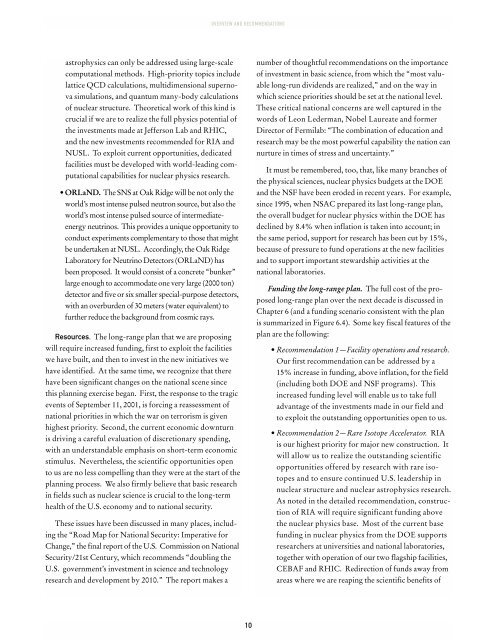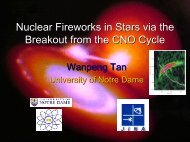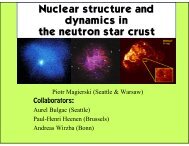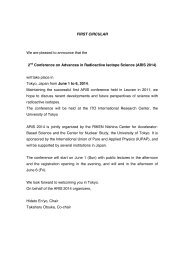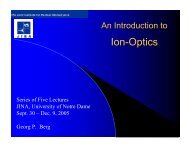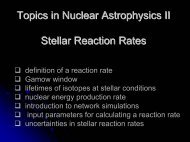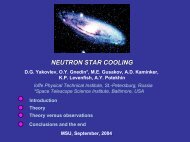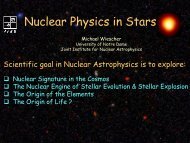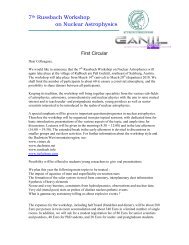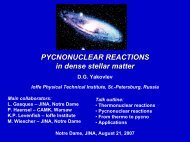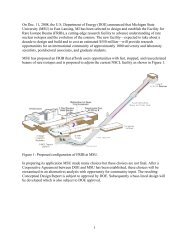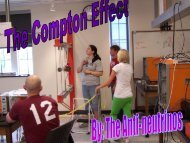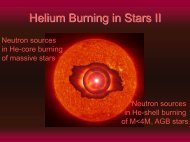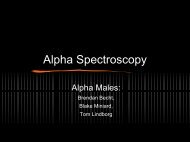OPPORTUNITIES IN NUCLEAR SCIENCE A Long-Range Plan for ...
OPPORTUNITIES IN NUCLEAR SCIENCE A Long-Range Plan for ...
OPPORTUNITIES IN NUCLEAR SCIENCE A Long-Range Plan for ...
Create successful ePaper yourself
Turn your PDF publications into a flip-book with our unique Google optimized e-Paper software.
OVERVIEW AND RECOMMENDATIONS<br />
astrophysics can only be addressed using large-scale<br />
computational methods. High-priority topics include<br />
lattice QCD calculations, multidimensional supernova<br />
simulations, and quantum many-body calculations<br />
of nuclear structure. Theoretical work of this kind is<br />
crucial if we are to realize the full physics potential of<br />
the investments made at Jefferson Lab and RHIC,<br />
and the new investments recommended <strong>for</strong> RIA and<br />
NUSL. To exploit current opportunities, dedicated<br />
facilities must be developed with world-leading computational<br />
capabilities <strong>for</strong> nuclear physics research.<br />
• ORLaND. The SNS at Oak Ridge will be not only the<br />
world’s most intense pulsed neutron source, but also the<br />
world’s most intense pulsed source of intermediateenergy<br />
neutrinos. This provides a unique opportunity to<br />
conduct experiments complementary to those that might<br />
be undertaken at NUSL. Accordingly, the Oak Ridge<br />
Laboratory <strong>for</strong> Neutrino Detectors (ORLaND) has<br />
been proposed. It would consist of a concrete “bunker”<br />
large enough to accommodate one very large (2000 ton)<br />
detector and five or six smaller special-purpose detectors,<br />
with an overburden of 30 meters (water equivalent) to<br />
further reduce the background from cosmic rays.<br />
Resources. The long-range plan that we are proposing<br />
will require increased funding, first to exploit the facilities<br />
we have built, and then to invest in the new initiatives we<br />
have identified. At the same time, we recognize that there<br />
have been significant changes on the national scene since<br />
this planning exercise began. First, the response to the tragic<br />
events of September 11, 2001, is <strong>for</strong>cing a reassessment of<br />
national priorities in which the war on terrorism is given<br />
highest priority. Second, the current economic downturn<br />
is driving a careful evaluation of discretionary spending,<br />
with an understandable emphasis on short-term economic<br />
stimulus. Nevertheless, the scientific opportunities open<br />
to us are no less compelling than they were at the start of the<br />
planning process. We also firmly believe that basic research<br />
in fields such as nuclear science is crucial to the long-term<br />
health of the U.S. economy and to national security.<br />
These issues have been discussed in many places, including<br />
the “Road Map <strong>for</strong> National Security: Imperative <strong>for</strong><br />
Change,” the final report of the U.S. Commission on National<br />
Security/21st Century, which recommends “doubling the<br />
U.S. government’s investment in science and technology<br />
research and development by 2010.” The report makes a<br />
number of thoughtful recommendations on the importance<br />
of investment in basic science, from which the “most valuable<br />
long-run dividends are realized,” and on the way in<br />
which science priorities should be set at the national level.<br />
These critical national concerns are well captured in the<br />
words of Leon Lederman, Nobel Laureate and <strong>for</strong>mer<br />
Director of Fermilab: “The combination of education and<br />
research may be the most powerful capability the nation can<br />
nurture in times of stress and uncertainty.”<br />
It must be remembered, too, that, like many branches of<br />
the physical sciences, nuclear physics budgets at the DOE<br />
and the NSF have been eroded in recent years. For example,<br />
since 1995, when NSAC prepared its last long-range plan,<br />
the overall budget <strong>for</strong> nuclear physics within the DOE has<br />
declined by 8.4% when inflation is taken into account; in<br />
the same period, support <strong>for</strong> research has been cut by 15%,<br />
because of pressure to fund operations at the new facilities<br />
and to support important stewardship activities at the<br />
national laboratories.<br />
Funding the long-range plan. The full cost of the proposed<br />
long-range plan over the next decade is discussed in<br />
Chapter 6 (and a funding scenario consistent with the plan<br />
is summarized in Figure 6.4). Some key fiscal features of the<br />
plan are the following:<br />
• Recommendation 1—Facility operations and research.<br />
Our first recommendation can be addressed by a<br />
15% increase in funding, above inflation, <strong>for</strong> the field<br />
(including both DOE and NSF programs). This<br />
increased funding level will enable us to take full<br />
advantage of the investments made in our field and<br />
to exploit the outstanding opportunities open to us.<br />
• Recommendation 2—Rare Isotope Accelerator. RIA<br />
is our highest priority <strong>for</strong> major new construction. It<br />
will allow us to realize the outstanding scientific<br />
opportunities offered by research with rare isotopes<br />
and to ensure continued U.S. leadership in<br />
nuclear structure and nuclear astrophysics research.<br />
As noted in the detailed recommendation, construction<br />
of RIA will require significant funding above<br />
the nuclear physics base. Most of the current base<br />
funding in nuclear physics from the DOE supports<br />
researchers at universities and national laboratories,<br />
together with operation of our two flagship facilities,<br />
CEBAF and RHIC. Redirection of funds away from<br />
areas where we are reaping the scientific benefits of<br />
10


